|
|
|
Sort Order |
|
|
|
Items / Page
|
|
|
|
|
|
|
| Srl | Item |
| 1 |
ID:
123111
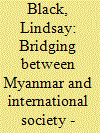

|
|
|
|
|
| Publication |
2013.
|
| Summary/Abstract |
Numerous academic works have critiqued Japan's Official Development Assistance (ODA) programme for being mercantilist and failing to promote democratization and human rights (Orr 1990; Rix 1993; Arase 1995, 2005). Such accounts assess Japan's ODA policy from Western theoretical perspectives that advocate Western approaches, such as military and economic interventions to contain repressive states. While receptive to these criticisms, Japanese policy-makers have perceived their country's international role in 'bridging' (kakehashi) terms and structured their ODA accordingly, as this paper details in the case of Japan's ODA policy towards Myanmar. 1
The rationale behind Japan's kakehashi approach lies in the construction of Japan's self-identity as a state able to reenter international society after World War II through focusing on economic development rather than military and coercive action. Proponents of the kakehashi approach construct Japan both as a model of successful democratization through development which other states can learn from, as well as the means through ODA to 'bridge' the divide between repressive regimes and liberal democratic capitalism. This critical approach examines Japan's kakehashi or bridging strategy in terms of Japan's response to the anti-government protests in September 2007, Cyclone Nargis in May 2008, and in the build up to parliamentary elections in November 2010 in Myanmar to demonstrate the permanence of this approach in spite of a change of government in Japan. In so doing, the kakehashi approach reveals opportunities to engage with, rather than contain, repressive regimes, thereby raising the possibility of enticing such states back into international society though economic incentives.
|
|
|
|
|
|
|
|
|
|
|
|
|
|
|
|
| 2 |
ID:
119271
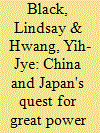

|
|
|
|
|
| Publication |
2012.
|
| Summary/Abstract |
In responding to piracy in the Gulf of Aden, both Chinese and Japanese policymakers have acted as norm entrepreneurs who intend to transform the dominant norms of international society. Chinese and Japanese norm entrepreneurship is grounded in the ways in which foreign policy actors construct and reconstruct their state identity. In China's case, policymakers have projected China's self-image as a responsible and benevolent Great Power that derives from the Chinese conception of Tianxia. Japanese foreign policy actors, on the other hand, have advanced the notion of Japan as a bridge that mediates between East and West, developing and developed states, members and non-members of international society. Although we do not advocate that Chinese or Japanese norm entrepreneurship should be accepted uncritically, we do maintain that there exist opportunities to combine and develop the multiple approaches that different states promote to problems. This article has shown that dealing with Somali piracy is one such case.
|
|
|
|
|
|
|
|
|
|
|
|
|
|
|
|
| 3 |
ID:
164966
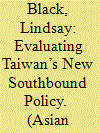

|
|
|
|
|
| Summary/Abstract |
Critiques of Taiwanese President Tsai Ing-wen’s New Southbound Policy overemphasize Beijing’s ability to hinder what is essentially a rational economic move that was already underway prior to Tsai’s inauguration. China’s antagonistic stance toward the New Southbound Policy merely pushes Taiwan into the hands of Japan, China’s regional rival.
|
|
|
|
|
|
|
|
|
|
|
|
|
|
|
|
| 4 |
ID:
155309
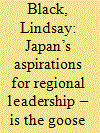

|
|
|
|
|
| Summary/Abstract |
Japan’s rise has often been conceived in terms of the ‘flying geese’ model in which Japan led a flock of emerging East Asian economies as its production networks expanded and it shed outdated technologies to the followers. Though the model implied a continuing Japanese leadership role in the East Asian region, two lost decades have undermined Japan’s claim to head the flock of ‘flying geese’ and Japan is often perceived as in decline relative to China’s rapid rise. This paper challenges such accounts to argue that Japan still has significant leadership ambitions and, potentially, the means to bring them to fruition. Understanding Japan’s leadership ambitions requires conceptualizing power in terms of discursive as well as material resources. Doing so highlights how different policymakers articulate contrasting visions of how Japan should take the lead in East Asia. These visions are of Japan as (variously) a functional leader, a conveyer of universal values, a conformist to ASEAN norms, a strategic partner and a promoter of open regionalism. Whilst most analyses have focused on Japan as a declining power, it is the spatial, temporal and ethical incompatibility of these regional visions that undermines Japan’s aspirations to lead the East Asian region.
|
|
|
|
|
|
|
|
|
|
|
|
|
|
|
|
| 5 |
ID:
171792
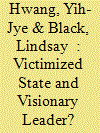

|
|
|
|
|
| Summary/Abstract |
Over the past decades, numerous critiques have emerged of China’s policy towards Africa. These critiques perceive China as a mercantilist or neocolonial power seeking to dominate the African continent through land grabs, exploitative trade deals, and resource extraction. These critiques do however not consider how the Chinese government has attempted to justify its aid policy towards Africa in ways that claim to secure human beings. Though the Chinese government has not officially adopted the concept of human security, it has engaged with the concept and developed its own interpretation of how human beings should be secured. This interpretation is based on the depiction of China as a state victimized through imperialism that has emerged in the twenty-first century as a global power with visionary ideas. Accordingly, Chinese policymakers believe they can offer an alternative model to Western interventions, imposition of neoliberal economic doctrine, and emphasis on democratization and human rights. In Africa, though China’s vision has generated benefits for some, it has also victimized others. China needs to critically reflect on and adapt its developmental vision if it truly intends to help human beings overcome the myriad challenges they face in their daily lives.
|
|
|
|
|
|
|
|
|
|
|
|
|
|
|
|
|
|
|
|
|